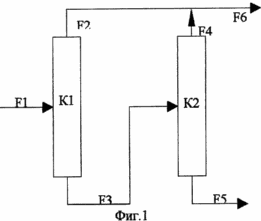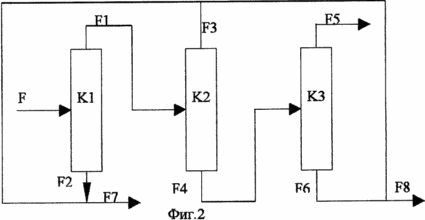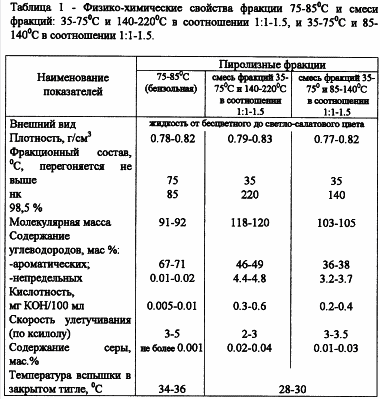| Start of section
Production, amateur Radio amateurs Aircraft model, rocket-model Useful, entertaining |
Stealth Master
Electronics Physics Technologies Inventions |
Secrets of the cosmos
Secrets of the Earth Secrets of the Ocean Tricks Map of section |
|
| Use of the site materials is allowed subject to the link (for websites - hyperlinks) | |||
Navigation: => |
Home / Patent catalog / Catalog section / Back / |
|
INVENTION
Patent of the Russian Federation RU2278143
![]()
METHOD FOR PROCESSING AND DISPOSING OF LIGHT PYROLYS RESIN
The inventor's name: Aleksei Sergeevich Kruchinin (RU); Fayzrakhmanov Nakip Notfollovich
The name of the patent holder: Limited Liability Company "SINTEZHIMINVEST"
Address for correspondence: 420097, Kazan, ul. Шмидта, 46, кв.8, В.Н. Sharifullin
Date of commencement of the patent: 2005.01.31
Use: oil refining and petrochemistry. Essence: the resin is divided into four fractions and the three fractions are mixed together. The step of the rectification separation proceeds in three steps to produce one finished product and three intermediate fractions: in the first stage, a fraction of 140-220 ° C is recovered from the resin as a bottoms residue; in the second stage, a light fraction of 35-75 ° is isolated from the remainder as a distillate C, and at the third stage, the remaining part is separated into a residual fraction of 85-140 ° C and the finished product is a benzene fraction of 75-85 ° C; At the mixing stage, two types of solvent are obtained: heavy by mixing the fractions of 35-75 ° C and 140-220 ° C in a ratio of 1: 1-1.5 and easy by mixing the fractions of 35-75 ° C and 85-140 ° C in a ratio of 1: 1-1.5. The technical result: expansion of assortment of received products.
DESCRIPTION OF THE INVENTION
The invention relates to a petrochemical industry, namely a process for the processing and utilization of light pyrolysis resin formed in the pyrolysis of a hydrocarbon feedstock.
A method for processing pyrolysis resin is known, with the production of stable gasoline components and a heavy pyrolysis resin used as a heating fuel as a marketable product. (Composition and processing of liquid pyrolysis products in domestic installations., Thematic Review, M .: TsNIIITneftekhim, 1977, p.55-62 ). For the production of gasoline components, the pyrolysis resin is subjected to a primary fractionation, then the 180 ° C. boiling fraction is hydrogenated on an alumopalladium sulfide catalyst at a temperature of 60-150 ° C. and a pressure of 25-28 atm, followed by distillation. A fraction with a boiling point of 130-180 ° C is used as a stable gasoline component. The light fraction after separation from the hydrocarbons C 4 -C 5 and used as a commodity gasoline component. The main disadvantages of the method are its technological complexity, energy intensity, the use of expensive catalysts.
A method for the thermal processing of pyrolysis resins with a boiling point not lower than 150 ° C is known (AS USSR No. 470118 dated 05.05.75, Bulletin No. 17) to produce thermostable aromatic hydrocarbon concentrates or high-index pitch. The resin is thermally treated for 10-1200 sec at 400-600 ° C and at a pressure of 20-200 atm. The product obtained is separated into a distillate and a residual fraction. The latter is subjected to further thermal treatment at a temperature of 380-480 ° C and a pressure of no higher than 50 ati for 1-10 hours. Disadvantages of this method are the complexity of the technological process, the high energy intensity and low yield of the main product.
 |
 |
The method closest to the proposed method is the processing of pyrolytic resin, a by-product of ethylene production (Patent No. 2178445 of the Russian Federation of January 20, 2002), with the production of a stable gasoline component as a marketable product. The process is carried out by a two-step rectification (FIG. 1). In the first stage of rectification, the first hydrocarbon stream F2 (fraction C5-C6) is withdrawn as distillate in the column K1 at a column bottom temperature of 165-170 ° C and at atmospheric pressure, and the bottoms of F3 are fed to the second separation stage. In column K2 at a column bottom temperature of 182-184 ° C and a residual pressure of 10-15 mm Hg. Art. The second hydrocarbon stream F4 (fraction C8-C10) is recovered as a distillate. To the output line of the flow F4, in order to increase the octane number of the stable gasoline component, the flow F2 is fed in a ratio of 8: 1-1.1. The bottoms of column K2 - heavy fraction C10-C12 are used as heating fuel. Disadvantages of this method are 1) the use of resin fractions as gasoline components can have not only a positive effect (increase in the octane number), but also a negative (increase in the content of cyclic hydrocarbons leading to the formation of carbon deposits); 2) incomplete utilization of pyrolysis resin (formation of a viscous product that is not suitable as a fuel component and has high coking ability); 3) high energy costs for the production of gasoline components due to the process of rectification under vacuum.
In the process of the invention, the processing of light pyrolysis resin is carried out in order to obtain three commercial products: commercial benzene fraction and two types of petroleum solvent.
A method for processing and utilizing a light pyrolysis resin to produce three organic solvents includes a step of dividing the resin into four fractions and a step of obtaining the products by mixing certain fractions. The rectification separation step (FIG. 2) proceeds in three columns (separation stages) at atmospheric pressure: in the first column K1, a heavy fraction F2 with a boiling point of 140-220 ° C is recovered from the resin as a bottoms residue, and distillate F1 is fed to the second separation stage ; In the second column K2, a light fraction with a boiling point of 35-75 ° C is isolated as a distillate F3, and the bottoms F4 are fed to the third separation stage; In the third column K3, a benzene fraction of 75-85 ° C is recovered as distillate F5 and as a bottoms residue F6, a residual fraction of 85-140 ° C. In the mixing stage, two types of solvent are obtained: a mixture of fractions of 35-75 ° C and 140-220 ° C in a ratio of 1: 1-1.5 and a mixture of fractions of 35-75 ° C and 85-140 ° C in a ratio of 1: 1-1.5. Resin processing products can be used in the petroleum industry to remove asphalt-tar deposits or as a solvent for paintwork materials.
The main physicochemical characteristics of the benzene fraction are 75-85 ° C and mixtures of fractions of 35-75 ° C and 140-220 ° C in a ratio of 1: 1-1.5, and a mixture of fractions of 35-75 ° C and 85-140 ° C in the ratio 1: 1-1.5 are given in Table 1.
Example 1 (according to the prototype) . A light pyrolysis resin in an amount of 3 tons is fed to the column K1, where the first hydrocarbon stream is recovered from it in an amount of 2 tons, and a bottoms quantity of 1 ton is fed to the second separation stage. In column K2, the mixture is separated into a second hydrocarbon stream in an amount of 0.25 tons and a heavy fraction of 0.75 tons, used as heating oil. Two hydrocarbon streams are mixed to produce 2.25 tons of a stable gasoline component. The yield of the basic product is 75%.
Example 2 (proposed method) . Light pyrolysis resin in the amount of 3 tons in the first stage is subjected to a 3-step rectification. In the first column K1, a 140-220 ° C fraction in the amount of 1 ton is isolated as a bottoms residue, and a 2 ton distillate is fed to the next separation stage. In the second column, K2 is isolated as a distillate of 0.8 tons of light fraction 35-75 ° C, and a bottoms quantity of 1.2 tons is fed to the next separation stage. In the third column, K3 is prepared as a distillate product - a benzene fraction of 75-85 ° C in an amount of 1.05 tons and as a bottoms residue of a fraction of 85-140 ° C in an amount of 0.15 tons. In the mixing stage, 1) a heavy solvent of 1.7 tons is produced by mixing 1 ton of heavy fraction 140-220 ° C. with 0.7 light fraction of light at 35-75 ° C; 2) a light solvent of 0.25 tons by mixing 0.15 tons of a residual fraction of 85-140 ° C with 0.1 tons of light fraction 35-75 ° C. The obtained solvents of three types can be used as pyrolysis solvents, which, according to their main operational properties and hydrocarbon composition, correspond to oil solvents of the Nefras-A and Nefras-S4 type.
Comparative characteristics of the process of processing light pyrolysis resin according to the prototype and according to the proposed method are given in Table 2.

| Table 2- Comparative characteristics of the process of processing light pyrolysis resin according to the prototype and according to the proposed method | ||
| Index | Prototype | The proposed method |
| Amount of initial resin, kg Quantity of products, kg: -Fraction of benzene Heavy solvent, -easy solvent, -stable gasoline component, -heating oil. Yield of the desired product,% Number of stages of separation |
3000 0 0 0 2250 750 75 2 |
3000 1050 1700 250 0 0 100 3 |
CLAIM
Method of recycling and disposal Light pyrolysis resin to obtain three organic solvents therefrom, comprising two steps: distillation separation and mixing of fractions, characterized in that in the separation step, the resin is dispersed into four fractions in three stages: in the first stage, a bottoms fraction 140 -220 ° C, in the second stage, the light fraction of 35-75 ° C is isolated from the remainder as a distillate, and in the third stage the remaining part is separated into a residual fraction of 85-140 ° C and the finished product is a benzene fraction of 75-85 ° C; At the mixing stage, two types of solvent are obtained from the intermediate fractions: "heavy" solvent - a mixture of fractions of 35-75 ° C and 140-220 ° C in the ratio 1: 1-1.5 and "light" solvent - a mixture of fractions of 35-75 ° C and 85-140 ° C in the ratio 1: 1-1.5.
print version
Publication date 20.02.2007gg




Comments
When commenting on, remember that the content and tone of your message can hurt the feelings of real people, show respect and tolerance to your interlocutors even if you do not share their opinion, your behavior in the conditions of freedom of expression and anonymity provided by the Internet, changes Not only virtual, but also the real world. All comments are hidden from the index, spam is controlled.